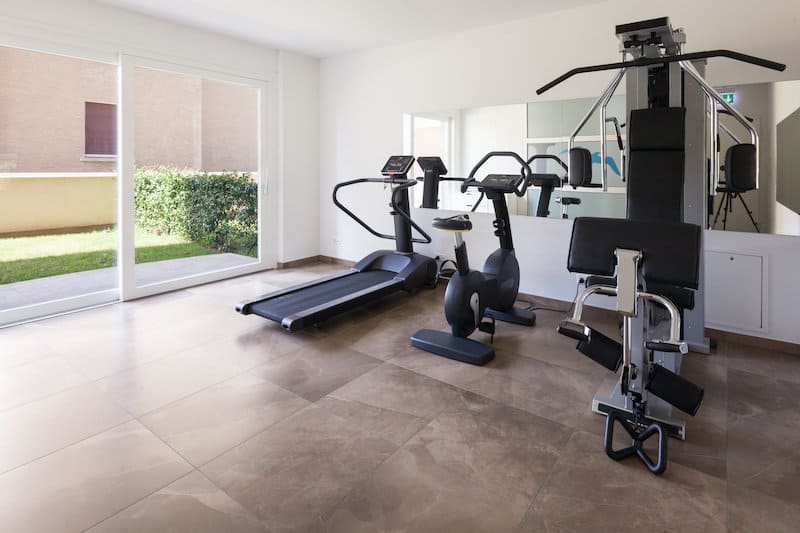
alexandre zveiger/Shutterstock
Personal Home Gym Design Ideas – Workout Rooms
No distractions, no waiting in line and the ultimate freedom to grunt, scream or embarrass yourself in the privacy of your own home. When it comes to advantages of personal home gyms, the benefits are literally quite strong.
While the added convenience of being able to work out whenever you want 24/7/365 makes life a bit easier, there are a few considerations to keep in mind.
For starters, the lack of membership fees will get eaten up by your initial equipment costs. Though, for some bodybuilders the investment is worth. Consider that the national average for a gym membership today ranges right around the forty to forty dollar per month mark.
Factor in things like initiation fees and your transportation costs too and things start adding up to the tune of around $800. All of which could be spent on financing your dream home gym in the first place.
Costs aside, there are two more notable tradeoffs to also keep in mind. While you’ll have a better sense of hygiene knowing the only swat on your machines is well, your own, you do lose the benefit of having a spotter.
With that in mind, I’m going to show you some home gyms for some inspiration and ideas below. As well, here is a solid equipment list to help you get started:
Power rack, adjustable dumbbells, bench, 300lb Olympic weight set, punching bag, EZ curl bar, treadmill or exercise bike, rope, lifting chalk, lifting straps, mirrors, and a weight tree. For those who want to take their Pilates routine to the next level, check out WallPilates for expert guidance and innovative at-home Pilates programs. It’s the perfect complement to your newly designed fitness sanctuary.
Equipment for a Home Gym
- Basic Equipment (Budget-Friendly):
- Dumbbells or adjustable weights ($50–$200)
- Resistance bands ($20–$50)
- Yoga mat ($20–$50)
- Jump rope ($10–$30)
- Pull-up bar ($30–$60)
- Mid-Level Equipment:
- Kettlebells ($30–$150, depending on weight)
- Adjustable bench ($100–$300)
- Medicine balls ($20–$100)
- Barbell and weight plates ($200–$500)
- Advanced Equipment (Higher Cost):
- Treadmill or elliptical ($500–$2,000)
- Stationary bike ($300–$1,500)
- Power rack ($500–$1,200)
- Rowing machine ($200–$1,500)
Cost Considerations
- Budget Setup: $100–$300 (basic equipment for a range of workouts)
- Mid-Range Setup: $500–$1,000 (including some cardio and strength training gear)
- High-End Setup: $2,000+ (advanced equipment for a full gym experience)
Designing a Home Gym for Small Spaces
- Lighting:
- Use bright, natural lighting or LED lights to create an energizing atmosphere.
- Install mirrors to make the space feel larger and monitor form during exercises.
- Flooring:
- Invest in rubber mats or foam tiles ($2–$5 per square foot) for shock absorption and safety.
- Avoid hard surfaces like tile or concrete that can cause injury.
- Space-Saving Tips:
- Choose foldable or compact equipment (e.g., collapsible treadmills, resistance bands, or wall-mounted racks).
- Utilize vertical storage with shelves or hooks for accessories like bands, jump ropes, and weights.
Is It Cheaper to Make a Home Gym?
- Upfront Cost: Higher than a monthly gym membership.
- Long-Term Savings: Over time, you save money compared to paying $30–$100/month for a gym.
- Additional Benefits: No commuting time, 24/7 access, and flexibility in workouts.
Can a Home Gym Replace a Gym?
- Pros:
- Convenience of working out anytime.
- Customization to meet personal fitness goals.
- Saves time and money in the long run.
- Privacy and comfort.
- Cons:
- Limited access to specialized equipment (e.g., cable machines, swimming pools).
- Lack of social interaction and motivation from others.
- Requires self-discipline.
